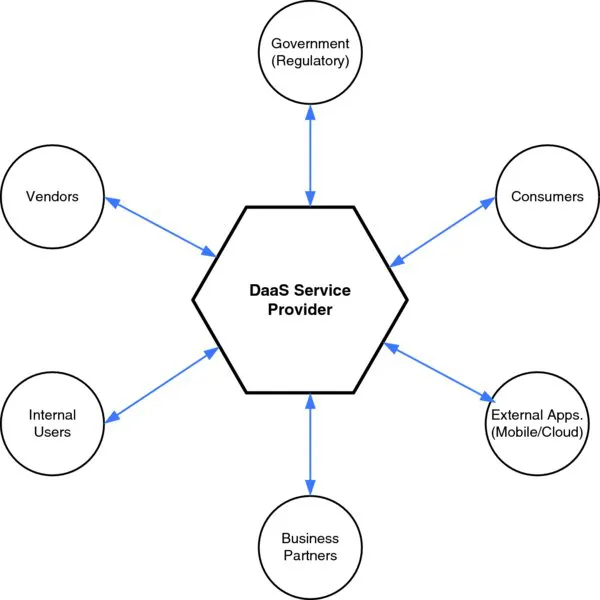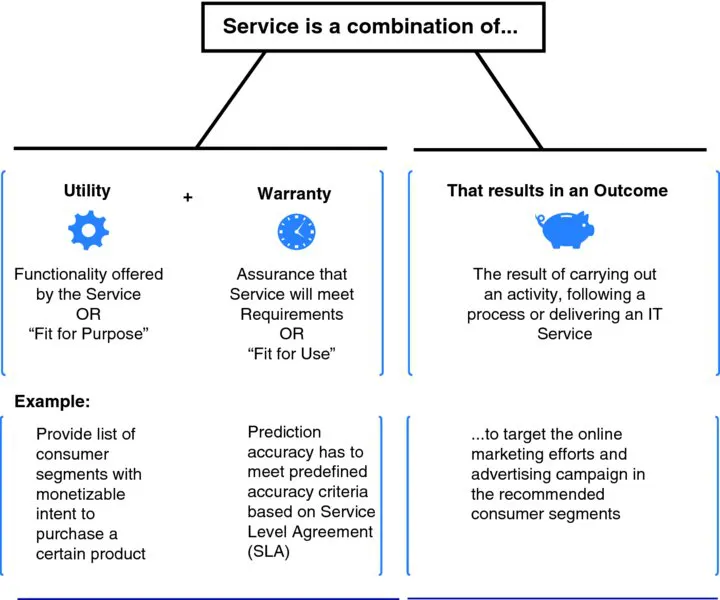
eBook - ePub
Data as a Service
A Framework for Providing Reusable Enterprise Data Services
- English
- ePUB (mobile friendly)
- Available on iOS & Android
eBook - ePub
About this book
Data as a Service shows how organizations can leverage "data as a service" by providing real-life case studies on the various and innovative architectures and related patterns
- Comprehensive approach to introducing data as a service in any organization
- A reusable and flexible SOA based architecture framework
- Roadmap to introduce 'big data as a service' for potential clients
- Presents a thorough description of each component in the DaaS reference architecture so readers can implement solutions
Frequently asked questions
Yes, you can cancel anytime from the Subscription tab in your account settings on the Perlego website. Your subscription will stay active until the end of your current billing period. Learn how to cancel your subscription.
At the moment all of our mobile-responsive ePub books are available to download via the app. Most of our PDFs are also available to download and we're working on making the final remaining ones downloadable now. Learn more here.
Perlego offers two plans: Essential and Complete
- Essential is ideal for learners and professionals who enjoy exploring a wide range of subjects. Access the Essential Library with 800,000+ trusted titles and best-sellers across business, personal growth, and the humanities. Includes unlimited reading time and Standard Read Aloud voice.
- Complete: Perfect for advanced learners and researchers needing full, unrestricted access. Unlock 1.4M+ books across hundreds of subjects, including academic and specialized titles. The Complete Plan also includes advanced features like Premium Read Aloud and Research Assistant.
We are an online textbook subscription service, where you can get access to an entire online library for less than the price of a single book per month. With over 1 million books across 1000+ topics, we’ve got you covered! Learn more here.
Look out for the read-aloud symbol on your next book to see if you can listen to it. The read-aloud tool reads text aloud for you, highlighting the text as it is being read. You can pause it, speed it up and slow it down. Learn more here.
Yes! You can use the Perlego app on both iOS or Android devices to read anytime, anywhere — even offline. Perfect for commutes or when you’re on the go.
Please note we cannot support devices running on iOS 13 and Android 7 or earlier. Learn more about using the app.
Please note we cannot support devices running on iOS 13 and Android 7 or earlier. Learn more about using the app.
Yes, you can access Data as a Service by Pushpak Sarkar in PDF and/or ePUB format, as well as other popular books in Computer Science & Computer Science General. We have over one million books available in our catalogue for you to explore.
Information
Part One
Overview of Fundamental Concepts
Chapter 1
Introduction to DaaS
Topics covered in this chapter
- This chapter introduces the Data as a Service (DaaS) framework and the approach taken by several organizations to introduce DaaS into their organization.
- It provides an introductory overview of the underlying drivers for transformation of data as a monetized asset and evaluates how commercial trends in the marketplace will further drive this service trend.
- It also suggests several key steps for preparing the blueprint for Enterprise Data Services in your organization. These steps include establishing a service delivery model (SDM) comprised of a service catalog, service governance, and a resourcing strategy.
- Finally, this chapter looks at commercialization aspects of data as a service, its potential for generating revenues as well as some of its common limitations.
The most profound technologies are those that disappear. They weave themselves into the fabric of our everyday life until they are indistinguishable from it.—Late Prof. Mark Weiser (Father of Ubiquitous Computing)
This book offers a huge undertaking to its readers. It aims to offer a definitive roadmap on how to significantly transform your organization by providing Data as a Service (DaaS) to consumers of your data across the enterprise. It also suggests ways to explore the promise of data and its expanded role as a strategic business enabler.
Using DaaS as the unifying conceptual framework, the book shows readers how they can successfully integrate distributed systems across heterogeneous platforms virtually and publish data to subscribers securely using industry data standards and governance mechanisms.
This introductory chapter provides an overview of the exciting possibilities around leveraging reusable data services across any organization as well as the economic value proposition of providing DaaS to your customers. It also explains the overall approach and necessary steps for any data provider to establish a service delivery model (SDM) for offering DaaS to subscribers.
Data-Driven Enterprise
In the words of Peter Drucker, a world-renowned management visionary, an information-based organization requires “clear, simple, and common objectives that translate into actions.”
In this chapter, we examine what these guiding objectives are and how they define the new persona of a successful information-based organization.
The DaaS framework presented in this book entails a paradigm shift in a fundamental sense, a shift that can help any organization transform itself into a data services-driven organization. Indeed, the DaaS framework can offer end users the capability to have convenient and timely access to data from multiple, heterogeneous data sources within the company as reusable data services. These data services can be useful to external and internal data subscribers, business partners, regulatory agencies, etc., (Figure 1.1). Additionally, this capability can be leveraged by some organizations interested in becoming commercial data providers, by publishing data for their customers and subscribers as a marketable service.

Figure 1.1 Daas in the business environment
For example, if we look at the high-tech sector, the underlying shift toward IT services is being driven by new advances in technology and its resulting societal consequences. In effect, many organizations need to change how they do business. They will need to respect demands from an increasingly tech-savvy generation of customers who now spend more time interacting with each other on mobile devices, through texting, and on social media sites.
All these factors have created a marketplace that will be dominated by organizations that understand new trends driving the global market. Organizations need to anticipate these changes before their competitors do and provide services rapidly whenever requested by their customers. Companies that undergo this business transformation are data-driven enterprises.
Concept of a Data Service Bus
To become more prompt and effective in responding to business or market demands, any service-based organization needs to place a larger emphasis on information sharing. The challenges faced while exchanging data usually result from a fragmented data environment made up of different platforms having no common standards. Consequently, the data entities and attributes of these systems often do not share the same syntax and semantics or even a common meaning, which is a necessary condition for systems to reliably share information. Currently, the majority of systems also have not been designed for data interoperability and sharing. This is where the DaaS framework can enhance the implementation of data services with the basic concept of a real-world Data Service Bus. The Data Service Bus can act as a key foundation for data reuse in any DaaS deployment.
For effective sharing of enterprise data across divisions, it is essential for large organizations to build an underlying data foundation (similar to a bus architecture) that provides a consistent view of enterprise-level data in the organization. The concept of a data service bus, which is a logical data abstraction layer created at the enterprise level, can act as a foundation for virtually sharing and reusing information across IT applications. However, it should not be confused with the enterprise service bus (ESB). In some ways, the Data Service Bus can be compared to a data broker that facilitates exchange of enterprise data from a DaaS Provider, or Data Provider, to its subscribers.
In my view, the true potential of DaaS can be realized by an organization if it sets up a well-architected Data Service Bus, comprising common data modules for reuse by downstream applications and customers as well as using standardized Enterprise Data Services. In addition to the data foundation layer, successful DaaS deployments also need to maintain standardized business logic and rules to process data that downstream systems can exploit (Figure 1.2).

Figure 1.2 Data Service Bus
To align the Data Service Bus with long-term business strategy, an organization interested in setting up DaaS should also establish an overall data strategy that integrates data from both internal and external data sources (social media, twitter feeds, etc.). Also recommended are the adoption of a few architectural principles and goals that will enable data sharing and interoperability across the enterprise as part of the DaaS architectural framework. This topic is explained in greater detail in Chapter 2 of this book.
Let us now try to understand the concept of a data-driven organization and what it means in the context of data-oriented services.
Defining a Service
Over the last few years, businesses have increasingly felt pressure to transform into providers of value-added services. Often, these services become necessary for customers to fulfill some of their daily needs. This concept is not entirely new or radically different from the traditional definition of a service. As per the Merriam-Webster's Collegiate dictionary, service is defined as a “facility supplying some public demand.” Consequently, in real life, we find the utility company providing households with water or electricity services. Similarly, a life insurance company exists in the service marketplace, primarily for fulfilling the need felt by most people for security and well-being (Figure 1.3).

Figure 1.3 Key features of a service
Any type of service displays a few common characteristics:
- It provides the means of providing a clear value to customers.
- It facilitates outcomes that the customers want to achieve.
- It is delivered through a few capabilities, while managing associated risks.
Service Taxonomy and Decomposition
In the context of DaaS, a data service is referred to as a remotely accessible, self-contained module that provides data to authorized service consumers to help them carry out their business. Consumers can access the service in a standardized manner that is well documented and listed in a service catalog. The catalog can provide consumers with the ability to find whether a service exists and its functionality.
Drivers for Providing Data as a Service
The increasing pressure to provide data services to customers is being confronted by organizations around the world. Along with other business drivers, this pressure is often caused by several technology advances in the IT sector.
Engaging Customers with Data-Driven Choices
Over the last few years, we have witnessed a large trend toward “social shopping.” Many online shoppers embrace the social-media ecosystem as their preferred channel. These shoppers usually conduct their own informal research by browsing products that they need or they find the latest products or services through what others find interesting on social media. For example, Facebook makes this process quite convenient by registering our likes and dislikes. Shoppers then compare online prices offered by different retailers, before committing to their actual purchase. Consequently, with this trend, a larger segment of customers have become dependent on the social network ecosystem and their online behavior will affect businesses on a significant scale in the fu...
Table of contents
- Cover
- IEEE Press
- Titlepage
- Copyright
- Dedication
- Guest Introduction
- Guest Introduction
- Preface (Includes the Reader's Guide)
- Acknowledgments
- Part One: Overview of Fundamental Concepts
- Part Two: DaaS Architecture Framework and Components
- Part Three: DaaS Solution Blueprints
- Part Four: Ensuring Organizational Success
- Appendix A: Data Standards Initiatives and Resources
- Appendix B: Data Privacy & Security Regulations
- Appendix C: Terms and Acronyms
- Appendix D: Bibliography
- Index
- EULA